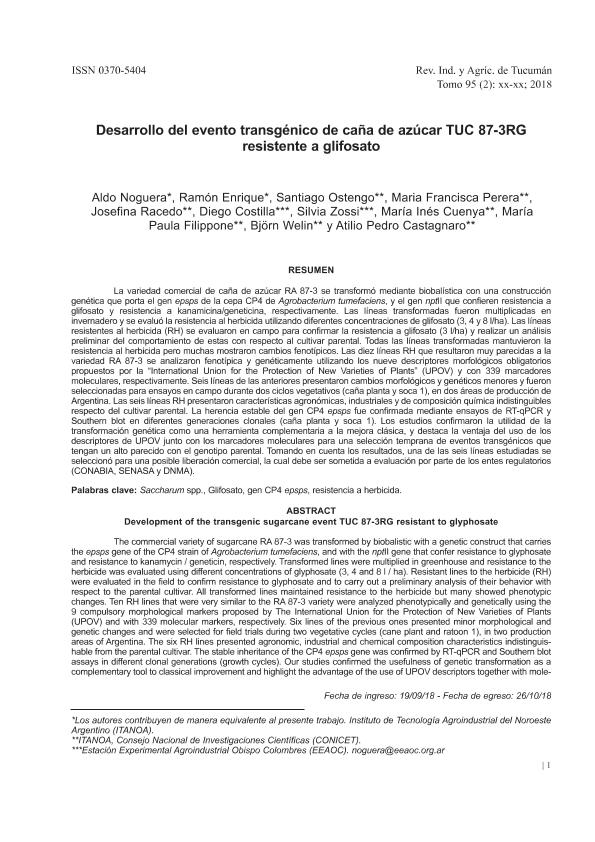Artículo
La variedad comercial de caña de azúcar RA 87-3 se transformó mediante biobalística con una construcción genética que porta el gen epsps de la cepa CP4 de Agrobacterium tumefaciens, y el gen nptII que confieren resistencia a glifosato y resistencia a kanamicina/geneticina, respectivamente. Las líneas transformadas fueron multiplicadas en invernadero y se evaluó la resistencia al herbicida utilizando diferentes concentraciones de glifosato (3, 4 y 8 l/ha). Las líneas resistentes al herbicida (RH) se evaluaron en campo para confirmar la resistencia a glifosato (3 l/ha) y realizar un análisis preliminar del comportamiento de estas con respecto al cultivar parental. Todas las líneas transformadas mantuvieron la resistencia al herbicida pero muchas mostraron cambios fenotípicos. Las diez líneas RH que resultaron muy parecidas a la variedad RA 87-3 se analizaron fenotípica y genéticamente utilizando los nueve descriptores morfológicos obligatorios propuestos por la “International Union for the Protection of New Varieties of Plants” (UPOV) y con 339 marcadores moleculares, respectivamente. Seis líneas de las anteriores presentaron cambios morfológicos y genéticos menores y fueron seleccionadas para ensayos en campo durante dos ciclos vegetativos (caña planta y soca 1), en dos áreas de producción de Argentina. Las seis líneas RH presentaron características agronómicas, industriales y de composición química indistinguibles respecto del cultivar parental. La herencia estable del gen CP4 epsps fue confirmada mediante ensayos de RT-qPCR y Southern blot en diferentes generaciones clonales (caña planta y soca 1). Los estudios confirmaron la utilidad de la transformación genética como una herramienta complementaria a la mejora clásica, y destaca la ventaja del uso de los descriptores de UPOV junto con los marcadores moleculares para una selección temprana de eventos transgénicos que
tengan un alto parecido con el genotipo parental. Tomando en cuenta los resultados, una de las seis líneas estudiadas se seleccionó para una posible liberación comercial, la cual debe ser sometida a evaluación por parte de los entes regulatorios (CONABIA, SENASA y DNMA). The commercial variety of sugarcane RA 87-3 was transformed by biobalistic with a genetic construct that carries the epsps gene of the CP4 strain of Agrobacterium tumefaciens, and with the nptII gene that confer resistance to glyphosate and resistance to kanamycin / geneticin, respectively. Transformed lines were multiplied in greenhouse and resistance to the herbicide was evaluated using different concentrations of glyphosate (3, 4 and 8 l / ha). Resistant lines to the herbicide (RH) were evaluated in the field to confirm resistance to glyphosate and to carry out a preliminary analysis of their behavior with respect to the parental cultivar. All transformed lines maintained resistance to the herbicide but many showed phenotypic changes. Ten RH lines that were very similar to the RA 87-3 variety were analyzed phenotypically and genetically using the 9 compulsory morphological markers proposed by The International Union for the Protection of New Varieties of Plants (UPOV) and with 339 molecular markers, respectively. Six lines of the previous ones presented minor morphological and genetic changes and were selected for field trials during two vegetative cycles (cane plant and ratoon 1), in two production areas of Argentina. The six RH lines presented agronomic, industrial and chemical composition characteristics indistinguishable from the parental cultivar. The stable inheritance of the CP4 epsps gene was confirmed by RT-qPCR and Southern blot assays in different clonal generations (growth cycles). Our studies confirmed the usefulness of genetic transformation as a complementary tool to classical improvement and highlight the advantage of the use of UPOV descriptors together with molecular markers for an early selection of transgenic events that have a high similarity with the parental genotype. Taking into account the results, one of the six lines evaluated was proposed for a possible commercial release, under the requirements of regulatory affairs offices (CONABIA, SENASA and DNMA).
Desarrollo del evento transgénico de caña de azúcar TUC 87-3RG resistente a glifosato
Título:
Development of the transgenic sugarcane event TUC 87-3RG resistant to glyphosate
Noguera, Aldo Sergio; Enrique, Ramón Atanasio ; Ostengo, Santiago; Perera, María Francisca
; Ostengo, Santiago; Perera, María Francisca ; Racedo, Josefina
; Racedo, Josefina ; Chayle Costilla, Diego Roberto; Zozzi. Silvia; Cuenya, María Inés
; Chayle Costilla, Diego Roberto; Zozzi. Silvia; Cuenya, María Inés ; Filippone, María Paula
; Filippone, María Paula ; Welin, Bjorn
; Welin, Bjorn ; Castagnaro, Atilio Pedro
; Castagnaro, Atilio Pedro
 ; Ostengo, Santiago; Perera, María Francisca
; Ostengo, Santiago; Perera, María Francisca ; Racedo, Josefina
; Racedo, Josefina ; Chayle Costilla, Diego Roberto; Zozzi. Silvia; Cuenya, María Inés
; Chayle Costilla, Diego Roberto; Zozzi. Silvia; Cuenya, María Inés ; Filippone, María Paula
; Filippone, María Paula ; Welin, Bjorn
; Welin, Bjorn ; Castagnaro, Atilio Pedro
; Castagnaro, Atilio Pedro
Fecha de publicación:
10/2018
Editorial:
Estación Experimental Agroindustrial Obispo Colombres
Revista:
Revista Industrial y Agrícola de Tucumán
ISSN:
0370-5404
Idioma:
Español
Tipo de recurso:
Artículo publicado
Clasificación temática:
Resumen
Palabras clave:
SACCHARUM SPP.
,
GLIFOSATO
,
GEN CP4 EPSPS
,
RESISTENCIA A HERBICIDA
Archivos asociados
Licencia
Identificadores
Colecciones
Articulos(ITA-NOA)
Articulos de INST. DE TECNOLOG. AGROINDUST. DEL NOROESTE ARGENTINO
Articulos de INST. DE TECNOLOG. AGROINDUST. DEL NOROESTE ARGENTINO
Citación
Noguera, Aldo Sergio; Enrique, Ramón Atanasio; Ostengo, Santiago; Perera, María Francisca; Racedo, Josefina; et al.; Desarrollo del evento transgénico de caña de azúcar TUC 87-3RG resistente a glifosato; Estación Experimental Agroindustrial Obispo Colombres; Revista Industrial y Agrícola de Tucumán; 95; 2; 10-2018; 1-13
Compartir



